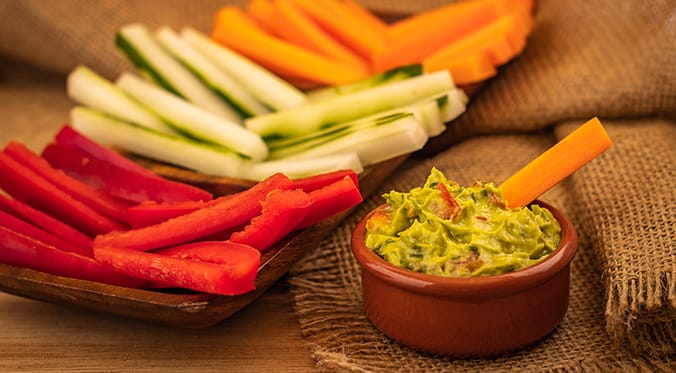PCF Recipe Club: Guacamole

Perhaps you’re remembering those loaded nachos from your Super Bowl party, with the big pile of guac at the center, and thinking, “Health food? No way!” But read on.
As you probably know, the main ingredient in guacamole is avocado, so it’s worth pausing to consider its individual health score. Avocados are a unique fruit (yes! Not a vegetable!) that can be traced back to early Central American societies as far as 10,000 years ago. Its nutrient profile is dense, but quite unusual, as it holds a large amount of fat. You might be taken aback when you see the high fat content (more than 80% of calories from fat, or 20+ grams if you eat a whole one!), but most of it comes from healthy monounsaturated fatty acids. These “good fats,” also found in olive oil and nuts, have been associated with lower cholesterol levels and risk of heart disease, and even a lower risk of mortality. Avocados are also a source of dietary fiber, folate, vitamin C, vitamin K, potassium and magnesium. In addition, avocados contain carotenoid compounds, which have anti-inflammatory and possibly anti-cancer benefits. Another bonus? Your body needs fat to absorb certain vitamins and other nutrients – the “good fat” naturally present in the avocado makes those vitamins more “bioavailable”. The verdict is that avocados are healthy in moderation, as long as you are not on an ultra-low-fat diet.
So what else is in guac that might make it so bad for you? Well if you make it like we suggest – with a healthy dose of vegetables from this list of whole foods – the answer is… nothing. Onions, garlic, tomato, jalapeño, cilantro, and lime are a few of the common ingredients that combine to give guacamole its unique taste.
Onions add a huge flavor boost to your guac, while giving you a dose of vitamin C and fiber. They also contain flavonoids and anthocyanins. Researchers have often observed flavonoids’ associations with anti-cancer and anti-inflammation properties.
Garlic has had a historical tie to medicinal benefits for thousands of years. Recent studies have pointed to a possible role of garlic in reducing cancer risk and in lowering blood pressure and cholesterol. A clove of garlic releases allicin, which has a positive impact on your gut microbiota. Both onions and garlic are scientifically classified as Allium vegetables, whose sulfur-containing compounds are of interest to researchers.
Tomatoes are a fantastic source of vitamins A and C as well as the antioxidant lycopene. Tomatoes have also been proposed to play a role in preventing prostate cancer. Remember the “good fat” in the avocado? The perfect pair with tomatoes to help your body absorb other good stuff.
Jalapeños’ color comes from their high carotenoid content. Carotenoids, like beta-carotene, convert into vitamin A, which plays an important role in healthy skin, teeth, and vision. In addition, jalapeños are great source of folate and fiber (granted, unless you are a spice fanatic, most people are not likely to eat enough of them to gain significant nutritional benefit!).
Cilantro contains flavonoids and has been associated with a host of health benefits, though additional research is needed. Don’t like cilantro? You’re not alone. Research suggests that upwards of 10% of people don’t care for it due to a variation in a single gene.
Limes contain vitamin C as well as small amounts of magnesium, potassium, and flavonoids. The juice serves as a natural preservative to keep your guacamole looking fresh and green.
What about salsa? We’re talking about almost all the same ingredients as guac, minus the avocado. You can do your salsa pico de gallo style (roughly translates to “beak of the rooster,” which refers to the traditional way of eating pico de gallo with your thumb and forefinger) or cooked. Pico de gallo is also called salsa fresca or salsa cruda, indicating that it contains all raw ingredients. If you prefer, you can cook the vegetables for your salsa. Note that if you cook the tomatoes, you possibly bestow other health benefits upon your dish (see PCF’s wellness guide, The Science of Living Well, Beyond Cancer, page 66 for a discussion on the possible effects of cooking tomatoes).
Lastly, what about the chips? As we often say, almost anything is ok in moderation, even a few fried organic corn chips. However, many corn chips are made with genetically modified (GMO) corn, which is controversial. GMO crops are purportedly more drought-tolerant and pest resistant, but critics charge that this is at the expense of the environment, the risk of exposure to dangerous forms of herbicides, and unknown health risks from allergens to cancer. However, it has yet to be determined what the actual health risks are. At PCF, we always recommend to buy local and organic (hence non-GMO) produce. You can check the bag to see if the chips you like have the non-GMO label. While the jury is still out on the long-term health effects of GMO corn consumption, you might also try thinly sliced veggies in the shape of chips to get the additional benefits of vitamins and fiber. On your way to a party? Many grocery stores have pre-cut fresh carrot “chips” in the produce section.
(except where noted, all ingredients should be finely chopped)
- 2 ripe avocados, smashed
- 1 tomato
- 2-3 tablespoons of onion
- 2-3 tablespoons of cilantro
- ½ of a jalapeño
- The juice of one small lime
- 1 clove of garlic, pulverized
- Salt and pepper to taste
Mix all chopped ingredients into the smashed avocados.
Serve with chips and fresh salsa or vegetables of your choice.
Yield: 4 servings









